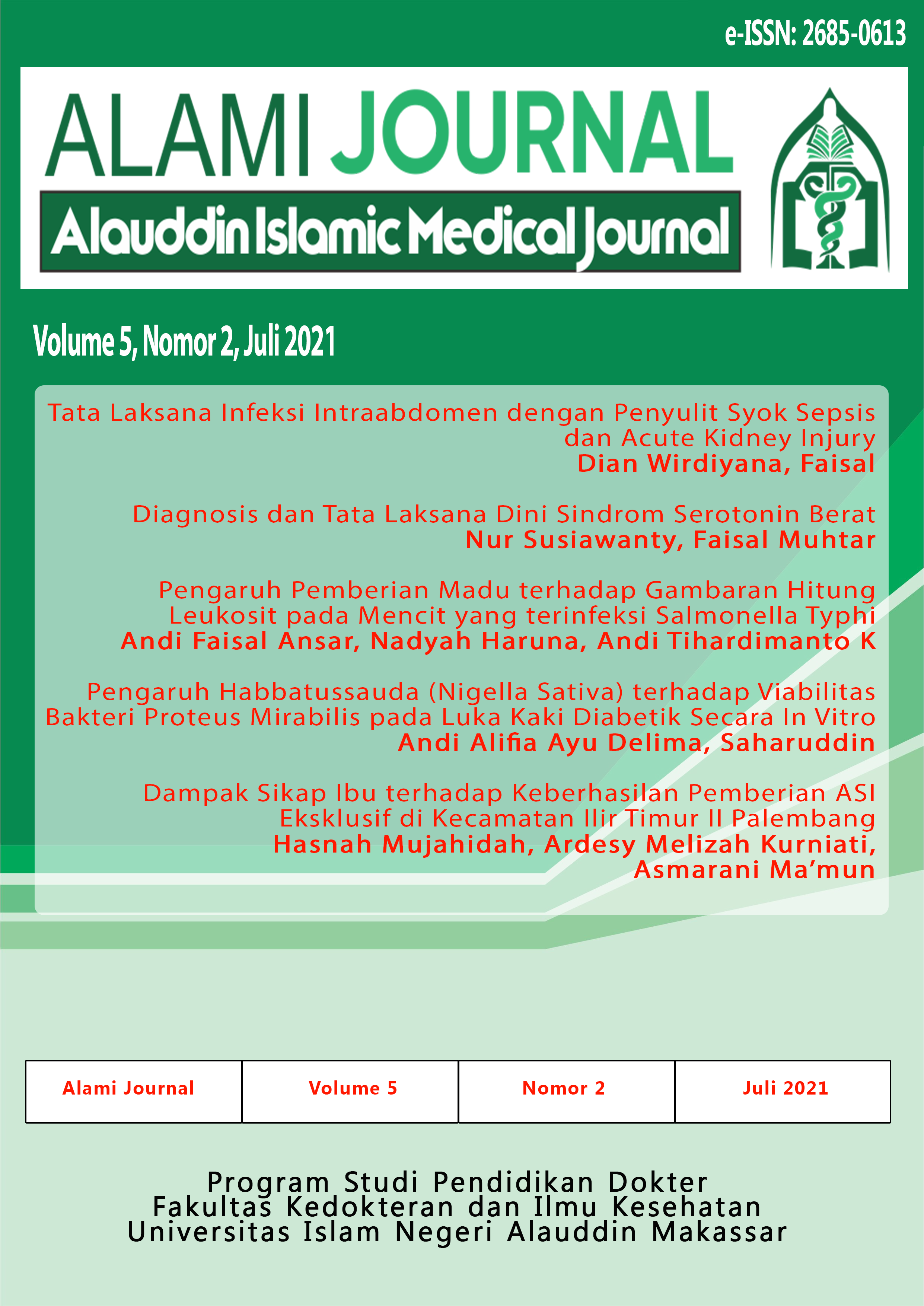TATA LAKSANA INFEKSI INTRAABDOMEN DENGAN PENYULIT SYOK SEPSIS DAN ACUTE KIDNEY INJURY
Abstract
Infeksi intraabdomen merupakan penyebab kedua tertinggi mortalitas yang berkaitan dengan infeksi di ICU. Infeksi intraabdomen sering dihubungkan dengan kejadian syok sepsis dan Acute Kidney Injury (AKI) dibandingkan dengan infeksi dari tempat lain. Pasien yang mengalami sepsis karena infeksi intraabdomen sebaiknya dilakukan kontrol sumber infeksi, perawatan di ICU dan terapi antimikroba yang tepat untuk mencegah komplikasi. Dilaporkan kasus pasien laki-laki, 20 tahun, dengan diagnosa infeksi intraabdomen disertai penyulit syok sepsis dan AKI, dilakukan tata laksana operasi laparotomy explorasi dan ileostomy serta tindakan Continues Renal Replacement Theraphy (CRRT). Telah dilaporkan sebuah kasus keberhasilan dan keamanan penerapan CRRT pada pasien peritonitis generalisata dengan penyulit syok sepsis dan AKI di ICU. Terapi ini dapat dipertimbangkan sebagai salah satu pilihan pada pasien dengan masalah yang sama bila sarana dan prasarana tersedia.
References
Rhodes A, Evans L E, Alhazzmi W, Levy M M, Antonelli M, et al. Surviving Sepsis Campaign: International Guidelines for Management of Sepsis and Septic Shock 2016. In: Dellinger R P, et al. Surviving Sepsis Campaign 2016. SCCM and ESICM 2017. Intensive Care Med. London, England, UK, 2017.
Ryotaro Kato and Michael R. Pinsky. Personalizing blood pressure management in septic shock:.Intensive Care (2015) 5:41
De Waele J, Lipman J, Sakr Y et al. Abdominal infections in the intensive care unit:characteristics, treatment and determinants of outcome. BMC Infect Dis 2014; 14:420
Vincent JL, Rello J, Marshall J et al. International study of the prevalence and outcomes of infection in intensive care units. JAMA 2009; 302: 2323–2329.
Yasser Sakr, Suzana M. Lobo, Rui P. Moreno, Herwig Gerlach, V. Marco Ranieri, Argyris Michalopoulus, Jean-Louis Vincent. Pattern and early evolution of organ failure and their relation to outcome, prospective study. Crit Care Med 2012; 16(6): R222.
Singer, M., Deutschman, C. S., Seymour, C. W., Shankar-Hari, M., Annane, D., Bauer, M., Bellomo, R., Bernard, G. R., Chiche, J.-D. & Coopersmith, C. M. 2016. The Third International Consensus Definitions For Sepsis And Septic Shock (Sepsis-3). Jama, 315, 801-10.
Dellinger RP, Levy MM, Rhodes A et al. Surviving Sepsis Campaign: International Guidelines for Management of Severe Sepsis and Septic Shock: 2012. Crit Care Med;41 (2): 580-636.
Vincent JL, et al. Sepsis in European intensive care units: Results of the SOAP study. Crit Care Med. 2006; 34: 344–353
Prowle JR, et al. Fluid management for the prevention and attenuation of acute kidney injury. Nature Reviews Nephrology. 2014; 10: 37-47.
Marik P. E. Iatrogenic salt water drowning and the hazard of a high central venous pressure.Annals of Intensive Care. 2014; 4: 21.
Dahaba A. A., et al. Procalcitonin and proinflammatory cytokine clearance durineg cvvhdf in septic patients. Anaesth Intensive Care. 2002 June; 30(3): 269-74.
Zhou F, et al. Blood Purification and Mortality in Sepsis: A Meta-Analysisof Randomized Trials. Crit Care Med. 2013; 41: 2209-2220.
Shapiro NI, et al. Serum Lactate as a Predictor of Mortality in Emergency Department Patients With Infection. Annals of Emergency Medicine. 2005; 45: 524-528.
Once an article was published in the journal, the author(s) are: granted to the journal right licensed under Creative Commons License Attribution that allows others to share the work with an acknowledgement of the work's authorship. permitted to publish their work online in third parties as it can lead wider dissemination of the work. continue to be the copyright owner and allow the journal to publish the article with the CC BY-NC-SA license receiving a DOI (Digital Object Identifier) of the work.


